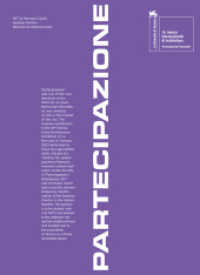- ホーム
- > 洋書
- > ドイツ書
- > Mathematics, Sciences & Technology
- > Earth Science
- > geography
Full Description
This edited volume examines how the arts and sciences have had to adapt, engage, confront, and even alter research, teaching, and community service because of modern media. The book describes how academics work with and through the media in their daily and professional lives. The acceleration of changes to media in the digital age has been astounding whether due to social media, web 2.0, new sensor technologies, fake news, or the rise of a post-truth news media economy. Many academics became media producers during COVID-19 having to engage in emergency remote teaching. Further, as academics, we can no longer publish our results and expect a metered response from all entities but rather must promote and defend our work in the media and the classroom. There is almost no part of academic work, let alone human life, that is not affected by media. Many academics across the sciences and humanities now embrace the media as part of their daily practice and actively engage in media production through building podcasts and convergent media sites, managing online courses and degree programs, or being administrators or educators who interact with the media regularly at local, national, or international scales. The chapters are original and written by a group of interdisciplinary junior and senior scholars from various world regions.
Contents
The Media Are Our Situation: An Introduction to Geography's Media Turn (Chris Lukinbeal and Stanley D. Brunn).- Part 1. The Pervasiveness and Dynamic Evolution of Media in Shaping Geographic Understanding.- From Spatial, Geographical to Pan-Geographical: Developmental Trajectories and Research Frameworks of the Chinese Film Geography (Qian Jiang and Chen Sihan).- The Urban-Rural Transformation in Chinese Cinema since 1978 (Wu Yanfang).- Media and Digitalization in Spatially Divergent Islands: Representing Archipelago Nature, Remoteness and Tourism Economy (Tommi Inkinen).- Part 2. Power, Representation, and the Unseen Geographies of Marginalization and Disinformation.- Geographies of Silence and Omission in West Africa: A Case Study of Senegal's Largest Humanitarian Disaster (Karen S. Barton).- Fake News and Post-Truth Geographies (Barney Warf).- Medial Constructions of Urban Imaginations (Stephan M. Pietsch).- Omaha's "Magic Geography:" Visualizing Racial Urban Placemaking in the 20th Century (Jeannette Gabriel and Christina E. Dando).- Part 3. The Interplay of Affect, Embodiment, and Lived Experience in Mediated Spaces.- Through the Aperture of the Parochial: Embodied Videography and Everyday (Circum)ambulation (Les Roberts).- Feminist Geography and Media Production for Online Teaching and Learning (Karen Falconer Al-Hindi).- Nomadic Voice: Internet Guerrilla, Affect, and Rhizomatic Knowledge Production in Fanpai Film Criticism Podcast (Lu Wang).- The Pacific Worlds Website: Representing Oceanic Indigenous Geographic Thought Through the Internet (RDK Herman).- Part 4. Film, Spectacle, and Shifting Realities.- The Nature of Spectacle: Arctic Amateur Documentary Film from the 1950s to Present (Daniel Grafton and Stuart C. Aitken).- The Visual Media Worlds of Zoo 2.0: From Caged Animals to Websites of Animal Rights and Welfare (Stanley D. Brunn and Shutian Li).- Fields of Becoming: Bourdieu, Deleuze, and the Concept of Beauty in The Substance (Jim Craine and Aleksandra Craine).- Projecting Places: Cinema's Crimes Against Geography and the Case of the Vampirization of Italian Locations (Giorgio Avezzù).- Star Wars Location Hunting: Film and Television Tourism as an Extension of Media Experience (Jacob Rowlett).- Database Film and the Terrestrial Imaginary (Floris Paalman and Haitian Ma).- Part 5. The Evolving Human-Technology Partnership in Media Production.- Artificial Intelligence and Media Geography: From the Personal to the Nonhuman (Chris Lukinbeal).- The Uneven Disciplinary Landscape of Academic Outputs from Extended Reality (XR) Labs at American Universities (A.R. Doery).








